Class Mammalia
Order Artiodactyla
Suborder Suiformes
Family Tayassuidae
Mylohyus—Long-nosed Peccary // Pecari tajacu—Collared Peccary // Platygonus—Platygonus Peccaries // Platygonus sp.—Platygonus sp. // Platygonus bicalcaratus—Cope's Peccary // Platygonus compressus—Flat-headed Peccary // Platygonus vetus—Leidy's Peccary
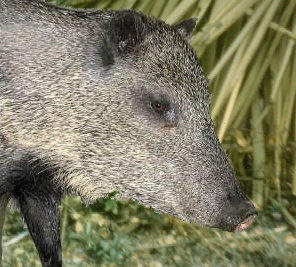 Peccaries have been limited
to the New World in post-Miocene times. Although somewhat pig-like, they have a long independent
evolutionary history. Unlike the true pigs (Suidae), the well-developed upper and lower canines are
straight rather than curved and the metatarsals are partially fused.
Peccaries have been limited
to the New World in post-Miocene times. Although somewhat pig-like, they have a long independent
evolutionary history. Unlike the true pigs (Suidae), the well-developed upper and lower canines are
straight rather than curved and the metatarsals are partially fused.
Peccaries generally run in small herds. The living form that reaches our region apparently has no fossil record in the U.S. unless the Ventana Cave record is correct. The Collared Peccary is known to have moved north in post-Pleistocene times. The northward movement continues today, now occurring considerably north of its range at the time the Southwest was entered by the Spanish.
The extinct peccaries seem either to have been rare in our region or to have had different habits than those farther east, where remains are not uncommon in cave faunas.
Fig. 1. Collared Peccary.
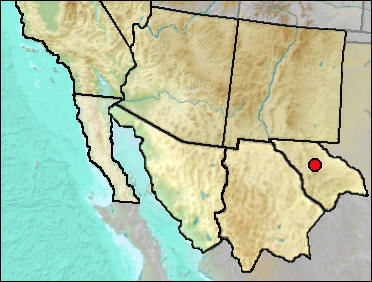
Kurtén and Anderson (1980) believed that only a single species (Mylohyus nasutus) of the genus occurred in the U.S. during the Rancholabrean. As befits the common name, the nose region was long and narrow. It appears to have been cursorial and probably non-gregarious. Size was about that of a small White-tailed Deer.
Distribution was in eastern and central United States. Our region apparently was marginal, with the only record coming from Trans-Pecos Texas. As with many large mammals, Mylohyus became extinct at the end of the Pleistocene. Fiedel (2009) lists the youngest date for the continent as 11,860 ± 40 BP from Sheridan Cave in Ohio.
Sites.
Late Wisconsin/Holocene: Fowlkes Cave (Dalquest and Stangl 1984b)
Czaplewski (2012) speculated that the fragmentary remains probably represent Platygonus rather than Mylohyus.
Literature. Czaplewski 2012; Dalquest and Stangl 1984b; Fiedel 2009; Kurtén and Anderson 1980.
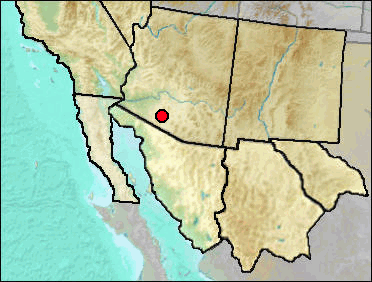
The Collared Peccary is the only member of the genus in our region at present.
The very tentative record of Collared Peccary from Dark Canyon Cave (Harris 1993c) is withdrawn. It likely pertains to some other peccary, but has not been critically evaluated.
There is only one published record of Pecari for the Pleistocene: Ventana Cave (Colbert 1950). Colbert recognized the possibility that the canine might represent Platygonus.
Sites.
Late Wisconsin: Ventana Cave (Colbert 1950: cf. gen.).
Literature. Colbert 1950; Harris 1993c.
Likely all of the Rancholabrean records listed here as Platygonus sp. belong to P. compressus, the middle and late Rancholabrean species (Kurtén and Anderson 1980). Kurtén and Anderson characterize the genus as having the rostrum moderately elongated, the premolars not molariform, molars bilophodont, and digits II and V reduced to splints or nodules.
Extinction was during terminal Pleistocene; Fiedel (2009) gives the youngest dates (for P. compressus) as 11,340 ± 50, 11,130 ± 60, and 11,060 ± 60 BP.
Literature.
Fiedel 2009; Kurtén and Anderson 1980.
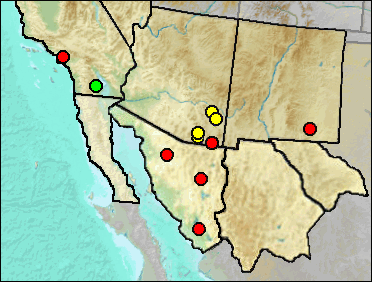
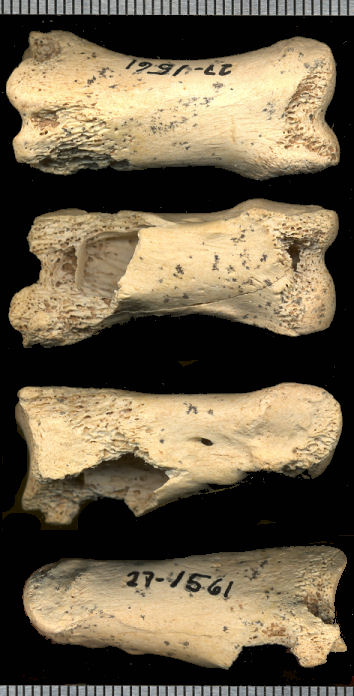
A single tayassuid first phalanx (Fig. 1) was recovered from the older deposits of Dry Cave. The specimen is considerably larger than the first phalanx of Pecari.
Fig. 1. Dorsal, ventral and two lateral views of a first phalanx of a tayassuid from the older deposits of Dry Cave.
Sites.
Late Blancan: 111 Ranch (Morgan and White 2005); Cal Tech (Lindsay 1984); Curtis Ranch (Lindsay 1985); Johnson Pocket (Johnson et al. 1975); San Simon Fauna (Morgan and White 2005).
Irvingtonian: Anza-Borrego (Murray 2008).
Rancholabrean: Bajimari (White et al. 2010); Centinella Park (Jefferson 1991b); La Playa (White et al. 2010); Térapa (White et al. 2010).
Early/Early-Mid Wisconsin: Rm Vanishing Floor (Harris 1993c: cf.).
Late Wisconsin: Murray Springs (Hemmings 2007a).
Literature.
Harris 1993c; Hemmings 2007a; Johnson et al. 1975; Lindsay 1984; Morgan and White 2005.
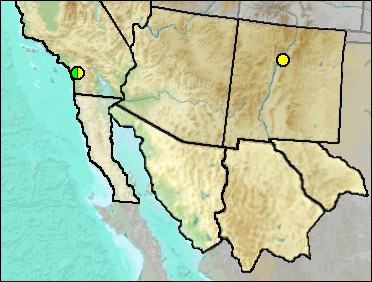
Although the holotype has little diagnostic value (Kurtén and Anderson 1980), material from a number of Blancan and early Irvingtonian sites has been assigned to the taxon. However, these records are the only Pleistocene occurrences for our region.
Sites.
Late Blancan: Santo Domingo (Morgan and Lucas 2003).
Late Blancan/Early Irvingtonian: Elsinore: Mimomys (Pajak et al. 1996).
Literature.
Kurtén and Anderson 1980; Morgan and Lucas 2003; Pajak et al. 1996.
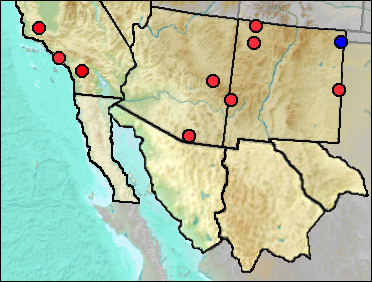
Synonyms: Platygonus alemanii
The Flat-headed Peccary occurred continent-wide south of the ice sheets, apparently in small herds and inhabiting open country (Kurtén and Anderson 1980). Kurtén and Anderson noted that the large number of individuals recovered from caves probably indicates that they sought shelter in caves. If this is the case, the dearth of remains in our region suggests conditions were marginal at best for them.
The specimen from Navajo Lake is of interest in that a large peccary canine was recovered during the excavation of an archaeological site during salvage operations before the Navajo Dam was emplaced. With no indication that it was not part of the archaeological material, it was suggested (Harris 1963) that perhaps it represented a trade item of the White-lipped Peccary from tropical America.
Sites.
Pleistocene: Perico Creek (Morgan and Lucas 2005).
Rancholabrean: Papago Springs Cave (Skinner 1942); Pit Stop Quarry (Murray et al. 2005); Shelton Canyon (Morgan and Lucas 2005).
Mid Wisconsin: McKittrick (Schultz 1937: cf.).
Mid/Late Wisconsin: Diamond Valley (Springer et al. 2009); Rancho La Brea (Stock and Harris 1992: cf.).
Late Wisconsin: Blackwater Loc. No. 1 (Morgan and Lucas 2005); Navajo Lake (Morgan and Lucas 2005); Sheep Camp Shelter (Gillespie 1985: cf. gen. et sp.).
Literature. Gillespie 1985; Harris 1963; Kurtén and Anderson 1980; Morgan and Lucas 2005; Murray et al. 2005; Schultz 1937; Skinner 1942; Springer et al. 2009); Stock and Harris 1992).
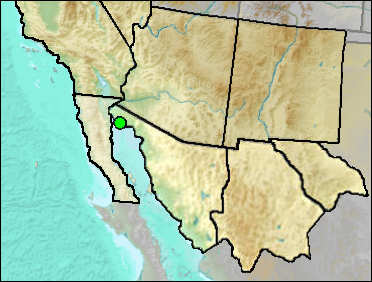
Sites.
Irvingtonian: El Golfo (Croxen et al. 2007: cf.).
Literature.
Last Update: 6 Aug 2014